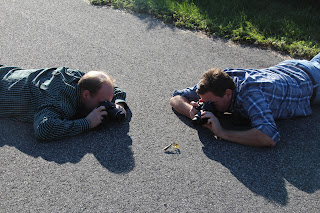 |
| Graduate students capturing images of the native grasslands |
The upper third of the watershed has largely been given over to standard suburban development; much of it is already a "lost cause." So, instead of starting at the source of the creek, we began the tour at the Pennypack Preserve in the central portion of the watershed and worked our way downstream over the course of the day.
After touring a portion of the protected land in the Pennypack Preserve and reviewing the forest restoration and native grassland creation projects underway, we enjoyed a picnic lunch then headed south into the city of Philadelphia for an overview of the lower third of the watershed. Within the city, the creek flows through Pennypack Park, a protected corridor of parkland, but the corridor only protects the steep slopes directly alongside the stream, not the creek's tributaries. Outside the park, development crowds right up to the edge of the woods.
 |
| Seasonal marsh occupying the site of a former parking lot |
 |
| Residential stormwater outfall restoration project |
 |
| Check dams and step pools in the stream valley |
 |
| Rapids at Pennypack Creek's fall line |
 |
| Students at the fall line, with the Frankford Avenue (King's Road) bridge in the background |
Our final stop of the day was on the coastal plain at the mouth of the creek at Pennypack on the Delaware. Here, the creek adds its flow to the Delaware River, which is also tidal. We arrived at low tide, and the mud flats flanking the mouth of the creek were fully exposed. The wetlands around the mouth of the creek are home to a pair of Bald Eagles, which started building a nest two years ago and have fledged chicks successfully each summer since.
 |
| Mud flats exposed at Pennypack Creek's mouth at the Delaware River |
 |
| The Philadelphia skyline, about seven miles distant |
 |
| A really hard day, or something exciting...? |
They were getting up close and personal with a preying mantis that had caught a sulfur butterfly and was making quick work of the victim.
After we returned to our vehicles, I sent the students back to New Brunswick, New Jersey, and I headed back to the 'burbs. A good day was had by all.
Submitted by
David Robertson, Executive Director


No comments:
Post a Comment